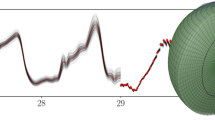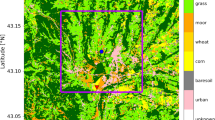Abstract
New data assimilation techniques have improved time-dependent estimates of the neutral atmospheric density, making it possible to better estimate the drag perturbation on low-Earth-orbiting satellites. This study looks at the potential for using satellite remote sensing from space as an effective density observation source in a data assimilation system. Changes in the neutral density can occur on a minute-to-minute basis, particularly during geomagnetic storms. Although coverage from only a few (two) satellites may be limited, remote sensing provides observations with a high temporal and spatial resolution. To quantify the effectiveness of the observing platform, a simulated “truth” neutral atmosphere is created using a physical model. This “truth” neutral atmosphere is sampled according to the mechanics of the remote sensing platform, and the results are statistically evaluated. With the resolution afforded by remote sensing, results show that two remote sensing satellites provide a stable solution of degree 4 (5 × 5) every ten minutes. Although coverage from two remote sensing satellites is limited, the coverage is sufficient to provide a pattern correlation coefficient consistently higher than 0.92.
Similar content being viewed by others
References
VALLADO, D. A. Fundamentals of Astrodynamics and Applications, McGraw-Hill Companies, Inc., New York, 1997, pp. 485–525, 651–658.
ALFONSO, G., BARLIER, F., BERGER, C., MIGNARD, F., and WALCH, J. J. “Reassessment of the Charge and Neutral Drag of LAGEOS and its Geophysical Implications,” Journal of Geophysical Research, Volume 90, 1985, pg. 9381.
RUBICAM, D. P. “Drag on the LAGEOS Satellite,” Journal of Geophysical Research, Volume 95, B4, 1990, pg. 4881.
FRITSCHE, B. and KLINKRAD, H. “Accurate Prediction of Non-Gravitational Forces for Precise Orbit Determination—Part I: Principles of the Computation of Coefficients of Force and Torque,” presented as paper AIAA-2004-5461 at the AIAA/AAS Astrodynamics Specialist Conference and Exhibit, Providence, Rhode Island, August 16–19, 2004.
FRITSCHE, B. and KLINKRAD, H. “Accurate Prediction of Non-Gravitational Forces for Precise Orbit Determination—Part II: Determination of Perturbing Forces and Torques in an Orbital Environment,” presented as paper AIAA-2004-5462 at the AIAA/AAS Astrodynamics Specialist Conference and Exhibit, Providence, Rhode Island, August 16–19, 2004.
DOORNBOS, E., SCHARROO, R., KLINKRAD, H., ZANDBERGEN, R., and FRITSCHE, B. “Improved Modelling of Surface Forces in the Orbit Determination of ERS and ENVISAT,” Canadian Journal of Remote Sensing, Volume 28, Number 4, 2002, pp. 535–543.
MARCOS, F. A., BASS, J. N., LARSON, D. R., LIU, J. J., and ROBINSON, E. C. “Satellite Drag Model Calibration and Feedback for Precision Low Earth Orbit Determination,” Proceedings of the 1997 Space Control Conference, MIT Lincoln Laboratory, L. B. Spence, ed., Lexington, Massachusetts, 1997.
MARCOS, F. A., KENDRA, M. J., GRIFFIN, J. M., BASS, J. N., LARSON, D. R., and LIU, J. J. “Precision Low Earth Orbit Determination Using Atmospheric Density Calibration,” The Journal of the Astronautical Sciences, Volume 46, Number 4, October–December 1998, pp. 395–409.
JACCHIA, L. G. “Revised Static Models of the Thermosphere and Exosphere with Empirical Temperature Profiles,” Smithsonian Astrophysical Observatory Special Report, Number 313, 1970.
JACCHIA, L. G. “Thermospheric Temperature, Density, and Composition: New Models,” Smithsonian Astrophysical Observatory Special Report, Number 375, 1977.
HEDIN, A. E. “A Revised Thermospheric Model Based on Mass Spectrometer and Incoherent Scatter Data: MSIS-83” Journal of Geophysical Research, Volume 88, 1983, pp. 10, 170-10, 188.
HEDIN, A. E. “MSIS-86 Thermospheric Model,” Journal of Geophysical Research, Volume 92, Number A5, 1987, May 1, 1987, pp. 4649–4662.
HEDIN, A. E. “Extension of the MSIS Thermosphere Model into the Middle and Lower Atmosphere,” Journal Geophysical Research, Volume 96, 1991, pp. 1159–1172.
PICONE, J. M., HEDIN, A. E., DROB, D. P., and AIKIN, A. C. “NRLMSISE-00 Empirical Model of the Atmosphere: Statistical Comparisons and Scientific Issues,” Journal of Geophysical Research, 107(A12), doi:10.1029/2002JA009430, 2002, pp. 1468–.
LIU, J. F. “Advances in Orbit Theory for an Artificial Satellite with Drag,” The Journal of the Astronautical Sciences, Volume 31, Number 2, April-June 1983, pp. 165–188.
MARCOS, F. A. “Accuracy of Atmospheric Drag Models at Low Satellite Altitudes,” Advanced Space Research, Volume 10, Number 3, 1990, pp. 417–422.
PARDINI, C. and ANSELMO, L. “Calibration of Semi-Empirical Atmosphere Models through the Orbital Decay of Spherical Satellites,” presented as paper 99–384 at the AAS/AIAA Astrodynamics Specialist Conference, Girdwood, Alaska, August 15–19, 1999.
YURASOV, V. S., NAZARENKO, A. I., CEFOLA, P. J., and ALFRIEND, K. T. “Results and Issues of Atmospheric Density Correction,” The Journal of the Astronautical Sciences, Volume 52, Number 3, July–September, 2004, pp. 281–300.
BOWMAN, B. R. “True Satellite Ballistic Coefficient Determination for HASDM,” presented as paper AIAA-2002-4887 at the AIAA/AAS Astrodynamics Specialist Conference and Exhibit, Monterey, California, August 5–8, 2002.
STORZ, M., BOWMAN, B., and BRANSON, J. “High Accuracy Satellite Drag Model (HASDM),” presented as paper AIAA-2002-4886 at the AIAA/AAS Astrodynamics Specialist Conference and Exhibit, Monterey, California, August 5–8, 2002.
CASALI, S. J. and BARKER, W. N. “Dynamic Calibration Atmosphere (DCA) for the High Accuracy Satellite Drag Model (HASDM),” presented as paper AIAA-2002-4888 at the AIAA/AAS Astrodynamics Specialist Conference and Exhibit, Monterey, California, August 5–8, 2002.
LAWSON, C. L. and HANSON, R. J. Solving Least Squares Problems, Prentice Hall, 1963.
LIEBELT, P. B. An Introduction to Optimal Estimation, Addison-Wesley, New York, 1967.
TAPLEY, B. D., SCHUTZ, B. E., and BORN, G. H. “Fundamentals of Orbit Determination: The Sequential Estimation Algorithm,” Statistical Orbit Determination, Chapter 4, Academic Press, 2004.
BOWMAN, B. R. and STORZ, M. F. “High Accuracy Satellite Drag Model (HASDM) Review,” presented as paper AAS 03–625 at the AIAA/AAS Astrodynamics Specialist Conference and Exhibit, Big Sky, Montana, August 3–7, 2003.
STORZ, M. F. “HASDM Validation Tool Using Energy Dissipation Rates,” presented as paper AIAA-2002-4889 at the AIAA/AAS Astrodynamics Specialist Conference and Exhibit, Monterey, California, August 5–8, 2002.
WISE, J. O., MARCOS, F. A., BOWMAN, B., KENDRA, M. J., and BASS, J. N. “AFRL Neutral Density Support to HASDM,” presented as paper AIAA-2002-4891 at the AIAA/AAS Astrodynamics Specialist Conference and Exhibit, Monterey, California, August 5–8, 2002.
BOWMAN, B. R. “HASDM/Sapphire Dragon Projects,” Atmosphere Neutral Density and Solar Indices Workshop, Colorado Springs, Colorado, October 12–13, 2005.
FULLER-ROWELL, T. J. and REES, D. “A Three-Dimensional, Time-Dependent, Global Model of the Thermosphere,” Journal of Atmospheric Science, Volume 37, 1980, pp. 2545–2567.
FULLER-ROWELL, T. J. and REES, D. “Derivation of a Conservative Equation for Mean Molecular Weight for a Two Constituent Gas Within a Three-Dimensional, Time-Dependent Model of the Thermosphere,” Planetary Space Sciences, Volume 31, 1983, pp. 1209–1222.
QUEGAN, S., BAILEY, G. J., MOFFETT, R. J., HEELIS, R. A., FULLER-ROWELL, T. J., REES, D., and SPIRO, J. “A Theoretical Study of the Distribution of Ionization in the High-Latitude Ionosphere and Plasmasphere: First Results on the Mid-Latitude Trough and the Light Ion Trough,” Atmosphere Terrestrial Physics, Volume 44, 1982, pp. 619–640.
FULLER-ROWELL, T. J., REES, D., QUEGAN, S., MOFFETT, R. J., CODRESCU, M. V., and MILLWARD, G. H. “A Coupled Thermosphere-Ionosphere Model (CTIM),” Solar-Terrestrial Energy Program: Handbook of Ionospheric Models, Scientific Committee on Solar Terrestrial Physics (SCOSTEP), August, 1996, pp. 217–238.
MINTER, C. F. Thermospheric Composition Forecasting Using Kalman Filtering Techniques, Ph.D. Dissertation, University of Colorado, August 2002.
SILVEY, S. D. “Multicollinearity and Imprecise Estimation,” Technometrics, Volume 11, October, 1969, pp. 539–552.
GOLDSTEIN, M. “The Poorly Conditioned Data on Multiple Regression Procedures,” British Journal of Mathematical Psychology, Volume 31, 1978, pp. 102–105.
MARCOS, F. A. “Analysis of Neutral Density from Drag, Accelerometers & Remote Sensing,” Atmosphere Neutral Density and Solar Indices Workshop, Colorado Springs, Colorado, October 12–13, 2005.
RISHBETH, H. and GARRIOTT, O. K. Introduction to Ionospheric Physics, Academic Press, London, 1969.
SCHUNK, R. W. and NAGY, A. F. Ionospheres: Physics, Plasma Physics, and Chemistry, Cambridge University Press, New York, 2000, pp. 216–220 and 344–345.
SOJKA, J. J. and SCHUNK, R. W. “A Theoretical Study of the High Latitude F Region’s Response to Magnetospheric Storm Inputs,” Journal of Geophysical Research, Volume 88, 1983, pp. 2112–2122.
PRÖLSS, G. W., BRACE, L. H., MAYR, H. G., CARIGNAN, G. R., KILLEEN, T. L., and KLOBUCHAR, J. A. “Ionospheric Storm Effects at Subauroral Latitudes: A Case Study,” Journal of Geophysical Research, Volume 96, 1991, pp. 1275–1288.
FOSTER, J. C., HOLT, J. M., MUSGROVE, R. G., EVANS, D. S. “Ionospheric Convection Associated with Discrete Levels of Particle Precipitation,” Geophysical Research Letters, Volume 13, 1986, pp. 656–659.
FULLER-ROWELL, T. J. and EVANS, D. S. “Height-Integrated Pedersen and Hall Conductivity Patterns Inferred from the TIROS-NOAA Satellite Data,” Journal of Geophysical Research, Volume 92, 1987, pp. 7606–.
FULLER-ROWELL, T. J., MATSUO, T., CODRESCU, M. V., and MARCOS, F. A. “Modeling Thermospheric Neutral Density Waves and Holes in Response to High-Latitude Forcing,” Advances in Space Research, Volume 24, 1999, pp. 1447–1458.
MCCOY, R. and THONNARD, S. “Special Sensor Ultraviolet Limb Imager,” Brochure of Praxis Inc., Naval Research Laboratory, Washington, D. C., 1997.
PAXTON, L. J., MENG, C.-I., FOUNTAIN, G. H., OGORZALEK, B. S., DARLINGTON, E. H., GARY, S. A., GOLDSTEN, J. O., KUSNIERKIEWICZ, D. Y., LEE, S. C., LINSTROM, L. A., MAYNARD, J. J., PEACOCK, K., PERSONS, D. F., SMITH, B. E., STRICKLAND, D. J., and DANIELL, R. E. “SSUSI: Horizon-to-Horizon and Limb-Viewing Spectrographic Imager for Remote Sensing of Environmental Parameters,” Ultraviolet Technology IV, SPIE, Vol. 1764, 1992, pp. 161–175.
EVANS, J. S., STRICKLAND, D. J., and WRIGHT, K. C. “SSUSI Dayside F2-Region Algorithm Language-Independent Description,” Technical Report No. 19, Version 3, Applied Physics Laboratory, Laurel, Maryland, April 1995.
STRICKLAND, D. J., EVANS, J. S., and PAXTON, L. J. “Satellite Remote Sensing of Thermospheric O/N2 and Solar EUV: 1. Theory,” Journal of Geophysical Research, Volume 88, 1983, pp. 2112–2122.
HOBSON, E. W. The Theory of Spherical and Ellipsoidal Harmonics, Chelsea Publishing, New York, 1931, reprinted in 1965.
CICCI, D. A. and TAPLEY, B. D. “Optimal Solutions of Unobservable Orbit Determination Problems,” Celestial Mechanics, Volume 44, 1988, pp. 339–369.
MONTGOMERY, D. C. and RUNGER, G. C. Applied Statistics and Probability for Engineers, John Wiley & Sons, Inc., New York, 1994, pp. 175–178, A-6, and A-7.
Author information
Authors and Affiliations
Corresponding author
Rights and permissions
About this article
Cite this article
Minter, C.F., Fuller-Rowell, T.J. & Codrescu, M.V. The Potential of Remote Sensing for Neutral Atmospheric Density Estimation in a Data Assimilation System. J of Astronaut Sci 53, 445–463 (2005). https://doi.org/10.1007/BF03546363
Published:
Issue Date:
DOI: https://doi.org/10.1007/BF03546363




